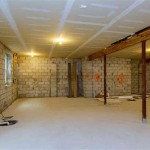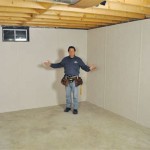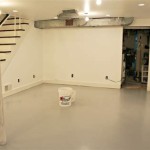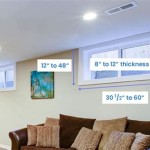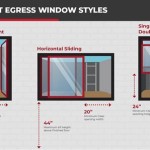What Is The Best Flooring For A Cement Basement?
Selecting the ideal flooring for a cement basement presents unique challenges compared to above-ground spaces. Cement basements are typically below grade, which means they are susceptible to moisture, temperature fluctuations, and potential flooding. Therefore, the chosen flooring material must be resilient to these conditions to prevent damage, mold growth, and maintain a comfortable environment. This article examines several flooring options suitable for cement basements, focusing on their advantages, disadvantages, and considerations for installation to assist in making an informed decision.
A primary concern when selecting basement flooring is moisture management. Cement is a porous material that can wick moisture from the ground, leading to dampness on the floor surface. This moisture can damage moisture-sensitive flooring materials like solid hardwood and carpet. Before installing any flooring, the basement should be assessed for existing leaks or high moisture levels. Corrective measures, such as sealing cracks in the foundation and installing a vapor barrier, are often necessary. A vapor barrier typically consists of a sheet of polyethylene plastic that is laid over the cement slab to prevent moisture from rising into the flooring above. Furthermore, ensuring proper ventilation in the basement can help reduce humidity levels.
The floor's thermal properties are another crucial consideration. Cement basements can be cold, particularly during the winter months. Some flooring materials offer better insulation than others, contributing to a warmer and more comfortable living space. Adding an underlayment with thermal properties can further enhance insulation regardless of the chosen flooring material.
Evaluating Popular Basement Flooring Options
Several flooring options are commonly used in cement basements, each with its own set of characteristics and suitability for different needs and preferences.
1. Engineered Wood Flooring: Engineered wood flooring offers the aesthetic appeal of solid hardwood but with enhanced moisture resistance. Unlike solid hardwood, which is susceptible to warping and damage from moisture, engineered wood consists of multiple layers of wood veneer bonded together. The top layer is a hardwood veneer, providing the desired appearance, while the underlying layers provide stability and resistance to moisture. Engineered wood can be installed as a floating floor, meaning it is not directly glued or nailed to the cement slab. This allows for expansion and contraction due to temperature and humidity changes, reducing the risk of warping or buckling. A vapor barrier is still recommended beneath the engineered wood to protect it from any moisture that may rise from the cement.
The advantages of engineered wood include its natural appearance, durability, and relative ease of installation. It also provides a degree of warmth underfoot compared to colder materials like tile. However, engineered wood is not entirely waterproof, and prolonged exposure to standing water can still cause damage. The cost of engineered wood can be higher than some other basement flooring options, and the quality can vary depending on the thickness of the hardwood veneer and the quality of the underlying layers.
2. Luxury Vinyl Tile (LVT) and Luxury Vinyl Plank (LVP): LVT and LVP are synthetic flooring options designed to mimic the appearance of natural materials like wood, stone, and tile. They are made from multiple layers, including a durable wear layer, a printed design layer, and a vinyl core. LVT comes in square or rectangular tiles, while LVP comes in planks that resemble wood flooring. Both LVT and LVP are highly water-resistant, making them a suitable choice for basements prone to moisture. They are also relatively easy to install, often featuring a click-lock system that allows the planks or tiles to be joined together without the need for glue or nails. LVT and LVP are available in a wide range of styles and colors, offering flexibility in design. They are also relatively affordable compared to some other flooring options.
The advantages of LVT and LVP include their water resistance, durability, ease of installation, and affordability. They are also comfortable underfoot and provide some degree of insulation. However, LVT and LVP are synthetic materials and do not have the same natural look and feel as wood or stone. While the wear layer is durable, it can be scratched or damaged by heavy objects. The underlayment choice impact the overall feel and performance.
3. Tile Flooring: Ceramic and porcelain tiles are excellent choices for cement basements due to their inherent resistance to water and moisture. Tile is also highly durable and can withstand heavy foot traffic and furniture. It is easy to clean and maintain, making it a practical choice for a basement environment. Tile is available in a wide variety of styles, colors, and sizes, allowing for a wide range of design possibilities. However, tile can be cold and hard underfoot, which can be a disadvantage in a basement. An area rug can mitigate this, or a radiant heating system can be installed beneath the tile to provide warmth.
Installing tile requires a cement backer board that provides a stable and moisture-resistant surface for the tile. A thin-set mortar is used to adhere the tile to the backer board, and grout fills the spaces between the tiles. The grout must be properly sealed to prevent water from seeping through. Tile installation can be more labor-intensive than some other flooring options, and it may require professional assistance. The advantages of tile include its water resistance, durability, and design versatility. However, it can be cold and hard underfoot, and installation can be more complex.
Addressing Moisture Concerns
Regardless of the flooring material selected, addressing moisture concerns is crucial for ensuring the longevity and performance of the floor. A vapor barrier is a fundamental component of any basement flooring installation. It prevents moisture from rising from the cement slab and damaging the flooring above. The type of vapor barrier used will depend on the specific flooring material and the moisture conditions in the basement. A thick polyethylene plastic sheet is commonly used, typically 6-mil or thicker. The vapor barrier should be carefully installed, ensuring that it is properly sealed at the seams and edges.
In addition to a vapor barrier, it is essential to address any existing leaks or cracks in the foundation. These should be repaired before installing any flooring. Improving ventilation in the basement can also help to reduce humidity levels. A dehumidifier can be used to remove excess moisture from the air. Regular maintenance, such as cleaning and inspecting the flooring for signs of moisture damage, can help to prevent problems from developing.
Considering Installation Methods
The method of installation can significantly impact the performance and longevity of basement flooring. Floating floors, such as engineered wood and LVT/LVP with click-lock systems, are often preferred in basements because they allow for expansion and contraction due to temperature and humidity changes. This can prevent warping or buckling. Floating floors are not directly attached to the cement slab, allowing for some movement. When using floating floors, ensure that the subfloor is level and free of debris. An underlayment is typically installed beneath the flooring to provide cushioning and reduce noise transmission.
Directly gluing or nailing flooring to the cement slab is generally not recommended for basements due to the potential for moisture damage. However, some flooring options, such as certain types of tile, may require direct adhesion. In these cases, it is crucial to use a moisture-resistant adhesive and follow the manufacturer's instructions carefully. Proper surface preparation is also essential. The cement slab should be clean, dry, and level before applying any adhesive.
When installing any type of flooring in a basement, it is essential to consult with a professional flooring contractor. A contractor can assess the specific conditions in the basement and recommend the most appropriate flooring material and installation method. They can also ensure that the installation is done correctly, minimizing the risk of future problems. DIY installations can save money, but a professional installation is generally recommended for basements to ensure long-term performance and prevent costly repairs.
Subfloor Preparation
Proper subfloor preparation is paramount before installing any type of flooring over a cement basement slab. The concrete surface must be clean, level, and dry. Any existing coatings, adhesives, or debris should be removed. This can be achieved through various methods, including scraping, grinding, or using chemical solvents. If the concrete surface is uneven, self-leveling compound can be applied to create a smooth and level base.
Testing for moisture content within the concrete slab is a crucial step. Several methods can be used, including calcium chloride tests or electronic moisture meters. The results of these tests will determine the appropriate type of vapor barrier needed and whether additional moisture mitigation measures are required. Addressing moisture issues before installing flooring is essential to prevent mold growth, adhesive failure, and flooring damage.
Cracks in the concrete slab should be repaired before proceeding with subfloor preparation. Small cracks can typically be filled with a concrete patching compound. Larger cracks may require more extensive repairs, such as crack injection or the application of a self-leveling overlay. Ignoring cracks can lead to uneven flooring and potential structural issues.
After cleaning, leveling, and repairing the concrete slab, applying a suitable primer or sealant can improve adhesion and prevent efflorescence—a white, powdery deposit that can form on the surface of concrete due to moisture. The appropriate primer or sealant will depend on the type of flooring being installed and the specific characteristics of the concrete.
Radiant Heat Considerations
For those seeking added comfort in their basement, radiant floor heating can be incorporated beneath certain types of flooring. Radiant heat systems provide consistent, even warmth from the floor up, eliminating cold spots and reducing energy costs. However, not all flooring materials are suitable for use with radiant heat.
Tile, stone, and engineered wood are generally compatible with radiant heat systems. These materials conduct heat effectively and do not expand or contract excessively with temperature changes. Luxury vinyl tile and plank can also be used with radiant heat, but it's essential to check the manufacturer's specifications to ensure compatibility. Solid hardwood flooring is typically not recommended for use with radiant heat due to its tendency to expand and contract significantly with temperature fluctuations, potentially leading to warping or cracking.
When installing radiant heat beneath flooring, it's crucial to follow the manufacturer's instructions carefully and use appropriate installation techniques. The heating elements should be embedded in a thin layer of concrete or a specialized radiant heat panel system. A temperature sensor should be installed to monitor the floor's surface temperature and prevent overheating.

What Is The Best Flooring For A Concrete Floor Basement Illinado Llc

Thermaldry Basement Flooring Systems Waterproof

How To Choose The Right Floor For Your Basement Gc Flooring Pros

A Guide To Stained Concrete Basement Floors

What Is The Best Flooring For A Concrete Floor Basement Illinado Llc

Best Basement Flooring The Warmest Floor Covering Is Cork

The Best Floors To Have Installed Onto Concrete Empire Today Blog

What S The Best Flooring For A Cement Basement Floor

Basement Flooring Options Choosing The Best Solutions
The Best Flooring Options For Your Basement America
Related Posts
